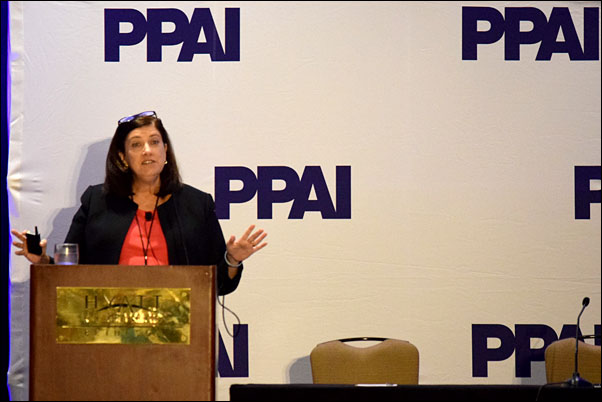Cheryl Falvey’s Summit Talk Asks Key Questions About Product Safety
The PPAI Product Responsibility Summit got off to a roaring start with this morning’s opening presentation by Cheryl Falvey, former general counsel of the Consumer Product Safety Commission (CPSC) and now partner with the Washington, D.C. firm, Crowell & Morning LLP. Falvey’s talk zeroed in on two key questions: Who is the regulator and what is the rule?
Her presentation discussed a number of common promotional products (a pig-shaped water squirter, novelty sunglasses and temporary tattoos, for example) about which marketers should carefully consider their descriptions, suggestions for use and claims. “How do you position your product on the website?” she asked, gesturing toward the pig-shaped product pictured on the screen and noting it could be used to deliver messages for farmers, grocers and restaurants but can become a children’s product depending on how it’s marketed. “Stress relievers are not considered toys, but when they are imprinted with children’s logos or are marketed as products for Little League games or schools, the rule changes.”
Falvey emphasized that the big question to ask is what is this product and for whom is it intended?
She also discussed the various regulators involved depending on the product category. For example, the regulators interested in novelty sunglasses are the FDA and CPSC. Real sunglasses are regulated as Class 2 medical devices and impact testing is strongly recommended on any glass or plastic lenses used in novelty eyewear. However, if marketing copy describes the novelty glasses as having 100 percent UV protection, the whole character of the product is changed and it then becomes a medical device.
Another promotional product, temporary tattoos, are considered cosmetics and require FDA approval of the color additives. Failure to meet the color additive requirements will cause the temporary tattoos to be “adulterated,” she says. It’s also important to know the product’s color additives and to obtain appropriate approvals and batch certification if needed. Falvey also advised her listeners to ensure the product is safe for use, is tested by a toxicologist and includes the proper directions and warning statements such as, “This product may cause skin irritation.”
Another category of promotional products she touched on are those made possible through technology such as wearable technology (bracelets that record steps, for example) and apparel that senses sweat and filters UV rays. These have attracted the attention of several regulators, she says, including the FDA, FCC (because of the wireless monitors), CPSC, FTC (because of the security, data protection, fabric and care instructions), the State of California (because of Prop 65, and Made in America status) and the EPA (because of the biocidals that react to microbes in the fabric).
Falvey advised that product marketing must be truthful and not misleading and must have adequate substantiation for all objective product claims, and disclosures and disclaimers must be clear and conspicuous.
Smart marketers will ask themselves these questions: What are the claims being made by this product? What is the intended use? What message is intended by the overarching promotion of the product?


